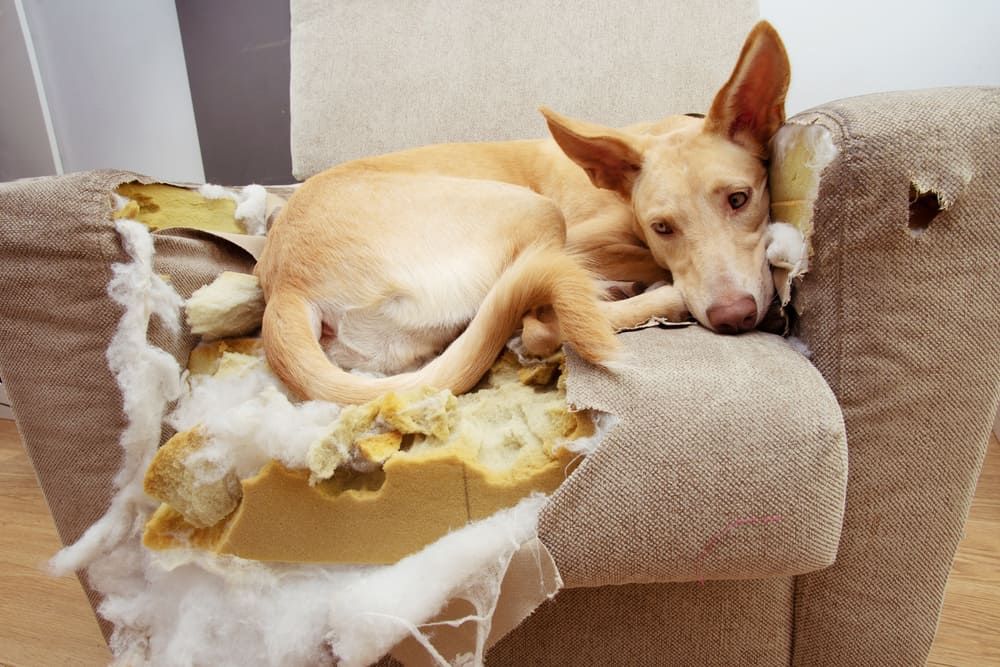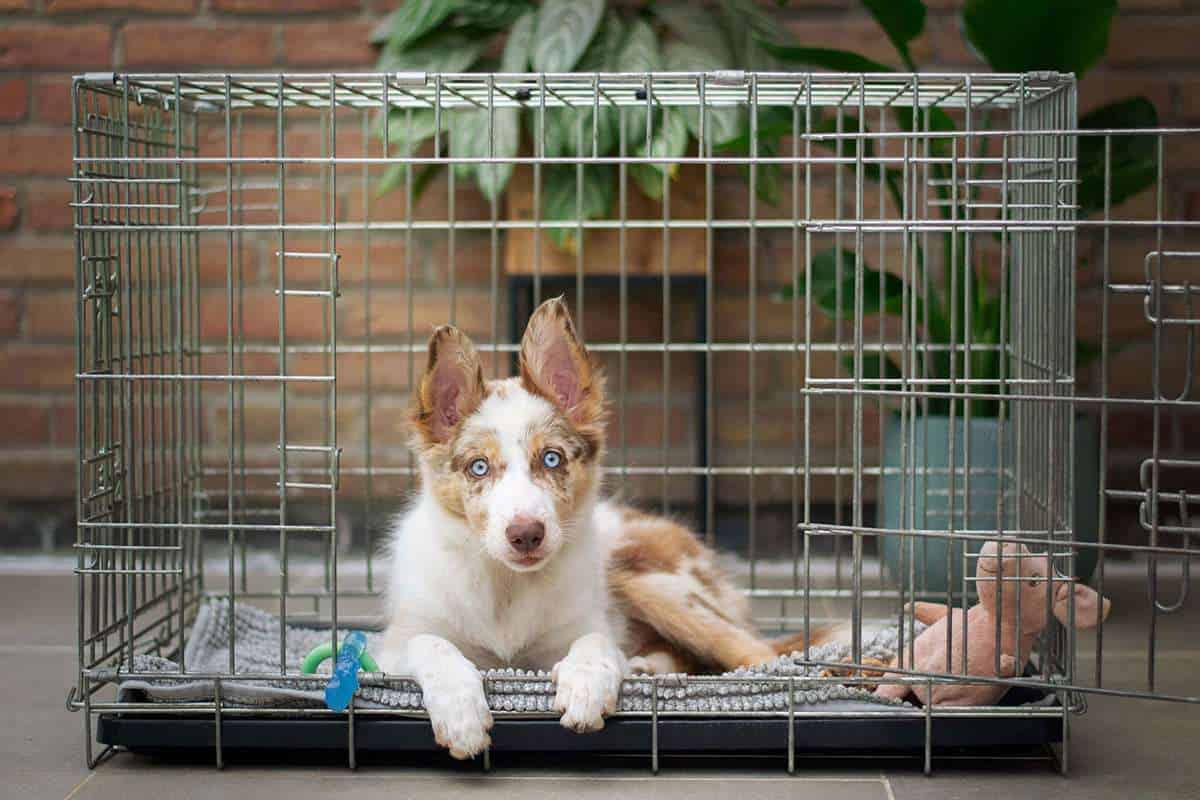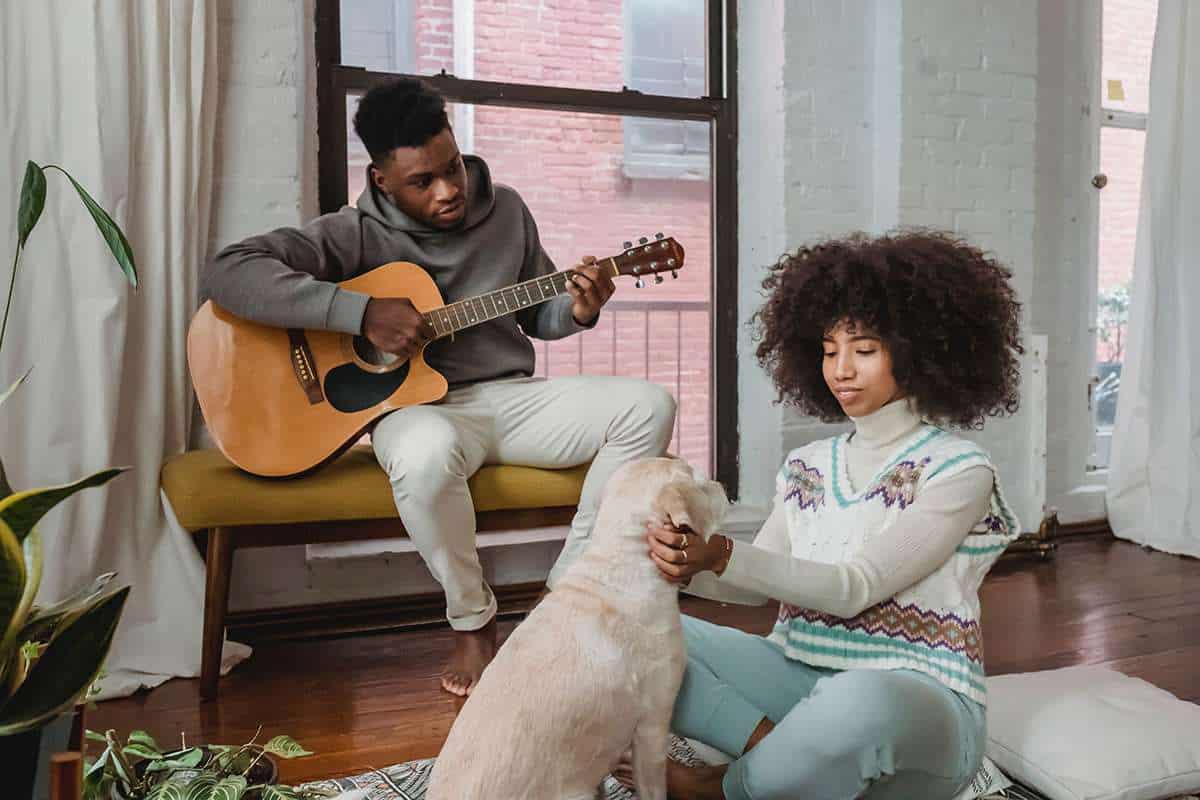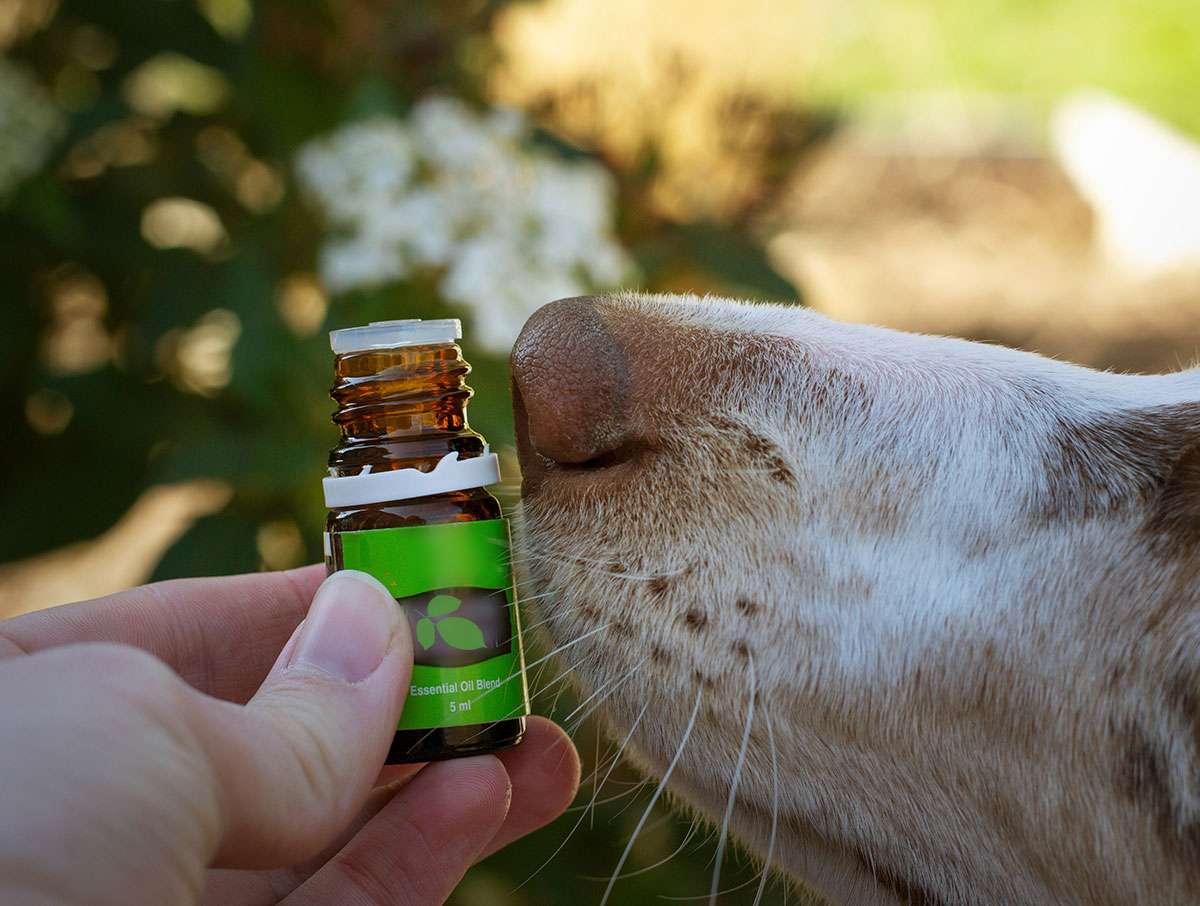If you have a dog with separation anxiety, you know how hard it is to leave your dog home alone.
You worry about them disturbing the neighbors or damaging the furniture, or even hurting themselves.
Separation anxiety is when a dog feels uneasy or stressed when left alone or apart from their favorite people.
It’s important to realize that our canine companions are simply trying to cope with these difficult emotions. They are coping the best they can and often require our help to make them feel more at ease.
In this article:
What causes separation anxiety?
Change
One common trigger is a significant change in the dog’s environment or daily routine.
Moving or changes in the owner’s schedule can unsettle a dog’s sense of stability. This can lead to increased anxiety when separated, as they adjust to the new and unfamiliar circumstances.
Loss
Another potential trigger could be the loss of a family member or another pet.
Dogs can form strong attachments to both humans and other animals in their environment. Sudden absence of a loved one can leave them feeling vulnerable and insecure.
Trauma
Traumatic events or experiences can also lead to sudden onset separation anxiety in dogs.
For example, dogs adopted from shelters or rehomed multiple times may suffer from separation anxiety.
An accident or natural disaster may leave the dog fearful that another traumatic event might occur in their owner’s absence.
Health
Underlying medical issues can sometimes contribute to the sudden development of separation anxiety.
They may become more anxious and clingy, seeking the comfort and support of their owner.
In such instances, a visit to the veterinarian is essential to rule out any medical issues.
Age
Puppies are susceptible to separation anxiety due to adjusting to their new environment and developing their sense of security. Understanding separation anxiety in puppies and addressing it early on can help prevent it from becoming a long-term problem.
Early separation from their mother and littermates (3-14 weeks) can contribute to separation anxiety.
Understanding separation anxiety in puppies and addressing it early on can help prevent it from becoming a long-term problem.
Lack of socialization
Limited exposure to people, animals, and environments during crucial socialization can make some dogs more prone to separation anxiety.
Lack of exercise or mental stimulation
When dogs don’t get enough exercise and mental stimulation, they may be more likely to show stress and anxiety-related behaviors.
Breed
Some breeds can be more prone to separation anxiety. For example, breeds that work closely alongside humans can be more susceptible to separation anxiety when left by themselves.
Signs and Symptoms of Separation Anxiety
Separation anxiety is a common struggle for many dogs and dog owners. The first step to addressing it is to recognize the signs and symptoms.
One of the symptoms is destructive behavior when left alone. Dogs may chew, scratch, or dig as a way to cope with their anxiety.
Some dogs with separation anxiety vocalize their distress with excessive barking, howling, or whining.
Even house-trained dogs may urinate or defecate inside the house when left alone. This can be emotionally distressing for the dog and the resulting clean up is not pleasant for you either
Dogs with separation anxiety may try to escape their confinement in an attempt to reunite with their owners. This can result in damage or injury if they escape or jump from a window.
Restless behaviors are common in dogs with separation anxiety. As they struggle to cope with their anxiety they may pace, pant, or drool when left alone.
Some dogs will refuse to eat or drink when left alone, which can be concerning for their overall health.
They may excessively lick or groom themselves, leading to hair loss or skin irritation.
Not all of these symptoms may be present in every dog with separation anxiety. Some dogs may exhibit additional or different symptoms depending on their personality and past experiences.
My dog has separation anxiety. How do I fix it?
Separation anxiety can be a challenging behavioral issue to manage. However, with patience and consistency, you can help your dog feel more secure and relaxed when left alone.
Anxiety can interfere with learning, so treatment often includes both medication and some form of behavior modification.
Here are some strategies that you can try to help manage your dog’s separation anxiety:
Gradual desensitization
The technique aims to safely expose your dog to anxiety triggers, like seeing you leave or hearing keys, in a controlled environment.
Gradually exposing your dog to longer periods of alone time can help desensitize them to being away from you.
Start with short absences and gradually increase the duration over time, always rewarding your dog for calm behavior.
Counterconditioning
Counterconditioning involves pairing the experience of being alone with something positive, such as a special treat or toy. Over time, your dog will learn to associate being alone with positive feelings and may become less anxious.
The goal of this technique is to change your dog’s emotional response to the stimuli that trigger their anxiety.
Crate Training
Crate training involves teaching your dog to feel comfortable and safe in a crate. This can provide them with a secure and calming environment when you’re not home.
Make sure the crate is large enough for your dog to stand up and turn around comfortably. Provide comfortable bedding and toys to make the crate a comfortable and inviting space.
Crate training is a gradual process that requires patience. Forcing your dog into the crate can lead to increased anxiety and negative associations with the space.
For the best result, combine crate training with other behavioral techniques like counterconditioning and desensitization.
Exercise and mental stimulation
Make sure to incorporate exercise and mental stimulation into your dog’s daily routine, especially before you leave them alone.
Regular exercise can help reduce anxiety in dogs by promoting the release of endorphins, natural mood-boosting chemicals in the brain.
Exercise also helps your dog burn off excess energy, which can lead to less destructive behavior when you’re not home. Try to provide your dog with at least 30 minutes of exercise per day with walks, runs, or playing fetch.
Mental stimulation is also important for reducing anxiety in dogs. Mental stimulation can be anything that engages your dog’s mind, such as training exercises, puzzle toys, or interactive games. These activities can help your dog feel more confident and relaxed.
If you can’t provide your dog with enough exercise and mental stimulation on your own, consider hiring a dog walker or pet sitter. They can provide your dog with additional exercise and attention, which can help reduce their anxiety when you’re not home.
Consistent routine
Here are some ways that having a consistent routine can alleviate separation anxiety:
Predictability: Dogs with separation anxiety often feel anxious and stressed when their owners leave because they don’t know what’s going to happen next. By having a consistent routine, your dog will know what to expect and may feel more relaxed and less anxious.
Reduced stress: Changes in routine or unexpected events can be stressful for dogs, especially those with separation anxiety. By having a consistent routine, you can reduce the amount of stress and uncertainty in your dog’s life, which can in turn reduce their anxiety.
Established patterns: Dogs are very good at picking up patterns and routines. If you consistently take your dog for a walk and play with them before leaving for work, they may feel less anxious about being left alone because they anticipate what comes next.
Better preparation: A consistent routine can also help you better prepare your dog for your departure. For example, if you always give your dog a special treat or toy when you leave, your dog may associate that treat or toy with your departure and be less anxious.
Try to keep your dog’s daily schedule as consistent as possible. This can include feeding times, exercise times, and play times.
Also try to establish a set routine for when you leave the house and when you return, such as giving your dog a treat or toy, and saying a specific phrase like “I’ll be back soon”.
Behavior modification
Behavior modification is a training approach that aims to change a dog’s behavior by using positive reinforcement and desensitization techniques. This method can be particularly effective in managing and treating separation anxiety in dogs.
Working with a professional animal behaviorist can help you develop a behavior modification plan tailored to your dog’s specific needs, taking into account their personality and preferences.
The plan may involve training techniques that utilize positive reinforcement, such as rewarding your dog for remaining calm and relaxed when left alone.
Behavior modification requires patience and consistency. The process can take time, but with the right approach and techniques, many dogs can learn to feel more comfortable and relaxed when left alone.
Medication
In some cases, medication may be necessary to help manage severe separation anxiety. Here are some medications that your vet might prescribe to treat separation anxiety:
Selective serotonin re-uptake inhibitors (SSRIs):
SSRIs work by increasing the levels of serotonin in the brain, which can help regulate mood and reduce anxiety.
Some common SSRIs used in dogs include fluoxetine (Prozac), sertraline (Zoloft), and paroxetine (Paxil).
Benzodiazepines:
These medications are fast-acting and can help calm a dog during a stressful event, such as being left alone. However, they are not recommended for long-term use because they can cause sedation and have a risk of addiction.
Some common benzodiazepines used in dogs include alprazolam (Xanax) and diazepam (Valium).
Tricyclic antidepressants (TCAs):
Simila to SSRIs, TCAs work by increasing the levels of certain neurotransmitters in the brain, which can help regulate mood and reduce anxiety.
Some common TCAs used in dogs include clomipramine (Clomicalm) and amitriptyline (Elavil).
Gabapentin: This medication is commonly used to treat pain, but can also be used for anxiety in dogs.
Gabapentin works by reducing the release of certain neurotransmitters in the brain, which can help reduce anxiety.
Your veterinarian will consider your dog’s overall health and behavior history before recommending a medication and will monitor your dog’s progress while on medication.
In addition to medication, it’s important to work on behavioral modification techniques, such as desensitization and counterconditioning, to help your dog overcome their separation anxiety.
Is a formal diagnosis necessary?
A formal diagnosis of separation anxiety in dogs isn’t required, but consulting a veterinarian or animal behaviorist has advantages.
Veterinarians or animal behaviorists can determine if your dog has separation anxiety or if the symptoms are due to other issues, including underlying medical issues that might be affecting your dog’s behavior
A diagnosis lets you receive professional guidance to address your dog’s separation anxiety effectively.
This may include behavior modification, training, or medication.
Working with a professional helps you create a tailored treatment plan to improve your dog’s quality of life and strengthen your bond.
What is the process?
The process starts with an owner interview. The professional asks questions about the dog’s behavior, including the onset, frequency, and severity of symptoms, and any specific triggers or situations.
Observing the dog’s behavior with and without the owner, both at home and possibly in a clinical setting, helps assess the dog’s reaction to separation and anxiety severity.
A thorough medical history examination and a physical examination help rule out underlying medical issues.
This may involve blood tests, urinalysis, or imaging studies.
The process also includes ruling out other possible causes for the dog’s symptoms, such as boredom or lack of exercise and considers the dog’s daily routine, exercise regimen, and socialization opportunities.
Finally, evaluating the dog’s living environment and the owner’s interactions with the dog helps identify factors contributing to separation anxiety.
This includes examining stressors in the home, evaluating the dog’s daily routine, and analyzing the owner’s training and reinforcement methods.
After completing the assessment and ruling out other potential causes, the professional can diagnose separation anxiety and recommend an appropriate treatment plan to manage the dog’s anxiety and improve their overall quality of life.
How do I prevent my dog from developing separation anxiety?
Prevention is focused on establishing healthy habits and routines early on in your dog’s life.
If possible, begin training and socializing your dog as a puppy. This helps to build a solid foundation of trust, confidence, and independence.
From the beginning, accustom your dog to short periods of alone time by leaving them alone for a few minutes and gradually increasing the duration. This helps them learn to cope with being alone without becoming anxious.
Encourage your dog to be more independent by not constantly engaging with them or being overly affectionate. This helps them learn to be comfortable on their own and not develop an over-reliance on your presence.
Praise and reward your dog for displaying independent behaviors, such as playing with toys or resting calmly without seeking your attention.
Resist the urge to constantly cuddle, carry, or coddle your dog, as this can create an unhealthy attachment that contributes to separation anxiety.
Expose your dog to various environments, people, and other animals to help them become more adaptable and well-adjusted.
Can separation anxiety be cured?
Although separation anxiety in dogs can be effectively managed and significantly reduced, it may not be entirely “cured” in all cases. However, through a combination of behavior modification techniques, desensitization, counterconditioning, and sometimes medication, dogs can learn to cope better with being alone, and their anxiety can be alleviated.
However, it’s important to note that each dog is unique, and results may vary depending on the individual dog’s personality, history, and specific circumstances. Consistency and patience are essential when working to manage a dog’s separation anxiety, and in some cases, ongoing management and maintenance may be necessary to keep the anxiety at bay.
Conclusion
Separation anxiety is a prevalent issue among dogs, causing distress when they are left alone. Understanding and addressing this anxiety is crucial for the well-being of both the dog and the owner. Here’s a summary of the major concepts discussed in the article:
- Understanding Separation Anxiety:
- It’s a condition where dogs feel stressed or uneasy when separated from their favorite humans.
- Dogs are trying to cope with their emotions and often need our assistance to feel more comfortable.
- Causes of Separation Anxiety:
- Change: Alterations in the dog’s environment or routine, like moving or a change in the owner’s schedule.
- Loss: The sudden absence of a family member or another pet.
- Trauma: Past traumatic events or experiences, including being rehomed multiple times or surviving natural disasters.
- Health: Underlying medical issues can lead to anxiety; a vet visit is essential.
- Age: Puppies adjusting to new environments or separated early from their mother can develop anxiety.
- Lack of Socialization: Limited exposure to varied environments or beings can make dogs prone to anxiety.
- Lack of Exercise or Mental Stimulation: Inactivity can lead to stress and anxiety-related behaviors.
- Breed: Some breeds, especially those that work closely with humans, are more prone to separation anxiety.
- Signs and Symptoms:
- Destructive behavior, vocalizing distress, house soiling, escape attempts, restlessness, refusal to eat or drink, and excessive grooming.
- Managing Separation Anxiety:
- Gradual Desensitization: Expose the dog to anxiety triggers in a controlled environment.
- Counterconditioning: Associate being alone with positive experiences.
- Crate Training: Make the dog feel safe and comfortable in a crate.
- Exercise and Mental Stimulation: Engage the dog physically and mentally to reduce anxiety.
- Consistent Routine: Establish predictable patterns to reduce uncertainty.
- Behavior Modification: Use positive reinforcement and desensitization techniques.
- Medication: In severe cases, drugs like SSRIs, Benzodiazepines, TCAs, or Gabapentin might be prescribed.
- Formal Diagnosis:
- Not always necessary, but consulting a professional can provide a tailored treatment plan.
- Prevention:
- Train and socialize the dog early, accustom them to alone time, encourage independence, and expose them to varied environments.
- Can It Be Cured?:
- While it can be managed and reduced, complete “cure” might not be possible for all dogs. Consistency, patience, and sometimes ongoing management are essential.
Remember, every dog is unique, and their response to treatments or interventions can vary. It’s essential to approach the issue with understanding and compassion.
For further information on separation anxiety, check out these sites:
- ASPCA – Treating Separation Anxiety in Dogs
- AKC – Separation Anxiety in Dogs: Causes, Prevention, and How to Stop




Leave a Reply